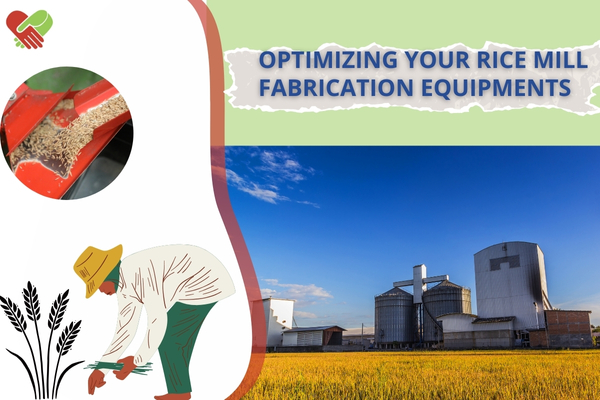Expert Tips for Maintaining and Optimizing Your Rice Mill Fabrication Equipment
Rice mill fabrication equipment plays a pivotal role in the efficiency and productivity of rice mills. To ensure the smooth operation and longevity of your equipment, it's crucial to adopt effective maintenance and optimization strategies. In this blog post, we'll delve into expert tips tailored for rice mill fabricators , offering insights into best practices that can enhance equipment performance and contribute to the overall success of your rice milling operations.
1. Regular Inspection and Cleaning:
Routine inspections are the foundation of effective maintenance. Regularly check all components of your rice mill fabrication equipment for wear, tear, or any signs of damage. Cleaning is equally important to prevent the accumulation of debris and contaminants that can compromise the machinery's functionality.
2. Lubrication for Longevity:
Proper lubrication is key to preventing friction and reducing wear and tear on moving parts. Regularly lubricate bearings, gears, and other crucial components to ensure smooth operation. Use high-quality lubricants recommended by the equipment manufacturer for optimal results.
3. Calibration and Alignment:
Calibrate and align your rice mill fabricators equipment regularly to maintain precision in the milling process. Misalignment can lead to inefficiencies and affect the quality of the final product. Invest time in ensuring that all components are correctly aligned for optimal performance.
4. Monitor and Control Moisture Levels:
Excessive moisture can lead to mold growth and reduce the quality of milled rice. Implement moisture monitoring systems to control and maintain optimal moisture levels during the milling process. This will contribute to the production of high-quality rice and extend the life of your equipment.
5. Replace Worn-Out Parts Promptly:
Identify and replace worn-out or damaged parts promptly. Delaying replacements can lead to more extensive damage and downtime. Keep an inventory of spare parts and collaborate with reliable suppliers to ensure you have timely access to the components your equipment may need.
6. Train and Empower Your Staff:
Provide comprehensive training for your staff on the operation, maintenance, and troubleshooting of rice mill fabricators equipment. Well-trained operators are more likely to identify potential issues early on, contributing to efficient maintenance practices and minimizing downtime.
7. Implement Safety Protocols:
Safety is paramount in any industrial setting. Establish and enforce safety protocols for the operation and maintenance of rice mill fabricators equipment. This includes providing protective gear, conducting regular safety training, and creating a culture of safety awareness among your team.
8. Embrace Technological Upgrades:
Stay informed about technological advancements in rice milling. Consider upgrading your equipment with the latest technologies designed to improve efficiency, reduce energy consumption, and enhance the overall performance of your rice mill fabricators machinery.
9. Collaborate with Professional Services:
Engage with professional services that specialize in the maintenance and optimization of rice mill fabrication equipment. Regular professional inspections and maintenance can uncover potential issues that might go unnoticed during routine in-house checks.
10. Foster a Preventive Maintenance Culture:
Shift from reactive maintenance to a proactive, preventive maintenance approach. Create a schedule for routine inspections, lubrication, and calibration, and encourage a culture that values preventive measures to ensure the longevity and efficiency of your rice mill fabricators equipment.
11. Optimize Milling Parameters:
Constantly monitor and optimize milling parameters to achieve the desired rice quality. Adjust settings such as milling duration, pressure, and flow rates based on the characteristics of the rice being processed. Regularly review and update these parameters to align with evolving production requirements.
12. Utilize Advanced Control Systems:
Invest in advanced control systems that offer real-time monitoring and automation capabilities. These systems can provide insights into the performance of your rice mill fabricators equipment and enable precise control over various milling processes. Integration of advanced controls enhances overall operational efficiency.
13. Efficient Waste Management:
Implement effective waste management practices to minimize environmental impact and reduce operational costs. Recycling systems for by-products, such as rice husks and bran, can contribute to sustainability while optimizing the use of resources within your rice mill fabricators facility.
14. Conduct Periodic Energy Audits:
Regularly assess energy consumption within your rice milling operations. Conducting periodic energy audits can identify areas for improvement, allowing you to implement energy-efficient technologies and practices. This not only reduces operational costs but also aligns with sustainable business practices.
Conclusion
Maintaining and optimizing your rice mill fabricators equipment is a proactive and ongoing effort that directly impacts the success of your rice milling operations. By implementing these expert tips, you can enhance the performance of your equipment, maximize productivity, and contribute to the production of high-quality rice in a sustainable and efficient manner.

